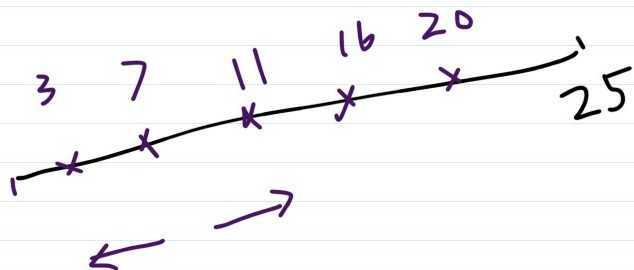标签:blog http io os sp for on div 2014
有这么一道题目, 看下面的图, 假设有一条直线, 每个叉叉上有一只蚂蚁, 它们会随机选择一个方向, 向前或者向后移动, 前进中当两只蚂蚁相遇, 它们会掉头, 问: 全部蚂蚁都走出去的最长和最短步数;

最短步数很明显...只要方向对了, 就是11;
最长呢...在看到问题时脑子里第一个反应是: 没有储存对这类问题的算法, 然后开始模拟蚂蚁行进路线, 发现可能性太多, 简直就是一个分子碰撞大混乱的情形...比如 3向右, 7向左, 11向左, 那样3和7碰撞, 7调头, 会和11碰撞, 然后在调头...脑子内存不够模拟...
然后我准备写一下代码:
// 蚂蚁路线问题: 一条直线上多只蚂蚁, 相遇则反转方向, 计算最长爬行距离
int pts[] = {0,1,2,3,4,5,6,7,8,9,10,11,12,13,14,15,
16,17,18,19,20,21,22,23,24,25};
class Ant {
public:
Ant(int p, int d): m_pos(p),m_direction(d) {}
void move(int x) {
if(m_direction > 0)
m_pos += x;
else
m_pos -= x;
}
void turnBack() {
m_direction *= -1;
}
int m_pos;
int m_direction;
};
Ant firstMeet(const QList <Ant>& list) {
// all the ants always ascending order
Ant a = list.first();
for (int i = 1; i < list.size(); i++) {
if(a.m_pos == list[i].m_pos)
return a;
}
}
void path() {
QList <Ant> aList;
Ant a1(3, 1); aList.append(a1);
Ant a2(7, 1); aList.append(a2);
Ant a3(11, 1); aList.append(a3);
Ant a4(16, -1); aList.append(a4);
Ant a5(20, -1); aList.append(a5);
bool antsLeave = false;
while (antsLeave) {
}
}
花了几分钟写到这里的时候, 停下来考虑要给Ant id, 给各种方向做所有的情况遍历...考虑有不只一对蚂蚁同时相遇的情况等等等等...我突然醒悟了....这不是程序题目, 如果你脑洞大一些, 就能明白, 最大值就是那个离开目标最远的蚂蚁要走的步数, 这里是22, 不劳烦计算机把所有case尝试一遍了;
标签:blog http io os sp for on div 2014
原文地址:http://www.cnblogs.com/roymuste/p/4148072.html